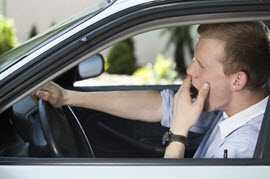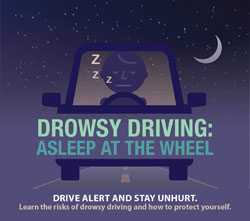Drowsy Driving

Drive alert and stay unhurt.
Learn the risks of drowsy driving and how to protect yourself.
Drowsy driving is a major problem in the United States. The risk, danger, and sometimes tragic results of drowsy driving are alarming. Drowsy driving is the dangerous combination of driving and sleepiness or fatigue. This usually happens when a driver has not slept enough, but it can also happen due to untreated sleep disorders, medications, drinking alcohol, and shift work.
What is Drowsy Driving?
Operating a motor vehicle while fatigued or sleepy is commonly referred to as “drowsy driving.”
The Impact of Drowsy Driving
Drowsy driving poses a serious risk not only for one’s own health and safety, but also for the other people on the road.
The National Highway Traffic Safety Administration estimates1 that between 2005 and 2009 drowsy driving was responsible for an annual average of:
- 83,000 crashes
- 37,000 injury crashes
- 886 fatal crashes (846 fatalities in 2014)
These estimates are conservative, though, and up to 6,000 fatal crashes each year may be caused by drowsy drivers.2-4
How Often Do Americans Fall Asleep While Driving?
- Approximately 1 out of 25 adults aged 18 years and older surveyed reported that they had fallen asleep while driving in the past 30 days.5,6
- Individuals who snored or slept 6 hours or less per day were more likely to fall asleep while driving.5
How Does Sleepiness Affect Driving?
Falling asleep at the wheel is very dangerous, but being sleepy affects your ability to drive safely even if you don't fall asleep. Drowsiness—
- Makes drivers less attentive.7
- Slows reaction time.7
- Affects a driver's ability to make decisions.7
The Warning Signs of Drowsy Driving
pull over to a safe place and take a 15-20 minute nap or change drivers.
Simply turning up the radio or opening the window are not effective ways to keep you alert.
For more tips on how to stay awake: Sleep Education
- Yawning or blinking frequently.
- Difficulty remembering the past few miles driven.
- Missing your exit.
- Drifting from your lane.
- Hitting a rumble strip.
For more warning signs visit the American Academy of Sleep Medicine.
Who Is More Likely to Drive Drowsy?
- Drivers who do not get enough sleep.
- Commercial drivers who operate vehicles such as tow trucks, tractor trailers, and buses.
- Shift workers (work the night shift or long shifts).
- Drivers with untreated sleep disorders such as one where breathing repeatedly stops and starts (sleep apnea).
- Drivers who use medications that make them sleepy.
How to Prevent Drowsy Driving
There are four things you should do before taking the wheel to prevent driving while drowsy.
- Get enough sleep! Most adults need at least 7 hours of sleep a day, while adolescents need at least 8 hours.8-9
- Develop good sleeping habits such as sticking to a sleep schedule.
- If you have a sleep disorder or have symptoms of a sleep disorder such as snoring or feeling sleepy during the day, talk to your physician about treatment options.
- Avoid drinking alcohol or taking medications that make you sleepy. Be sure to check the label on any medications or talk to your pharmacist.
For healthy sleep tips and more information about sleep disorders visit the American Academy of Sleep Medicine’s sleep education site: http://www.sleepeducation.com/
Drowsy Driving Is Similar to Drunk Driving

Your body needs adequate sleep on a daily basis. The more hours of sleep you miss, the harder it is for you to think and perform as well as you would like. Lack of sleep can make you less alert and affect your coordination, judgement, and reaction time while driving. This is known as cognitive impairment.
Studies have shown that going too long without sleep can impair your ability to drive the same way as drinking too much alcohol.
- Being awake for at least 18 hours is the same as someone having a blood content (BAC) of 0.05%.10-12
- Being awake for at least 24 hours is equal to having a blood alcohol content of 0.10%. This is higher than the legal limit (0.08% BAC) in all states.12-13
Additionally, drowsiness increases the effect of even low amounts of alcohol.14-15
Resources

Researchers estimate that more than 70 million Americans suffer from a sleep disorder. (Institute of Medicine, 2005).16
Infographic [PDF-152 KB]
General Information:
Sleep Education: Drowsy Driving
National Sleep Foundation: Drowsy Driving
For shift workers:
http://www.cdc.gov/niosh/topics/workschedules/
http://www.nhtsa.gov/people/injury/drowsy_driving1/human/drows_driving/index.html
About sleep disorders:
References
- National Highway Traffic Safety Administration. Research on Drowsy Driving. http://www.nhtsa.gov/Driving+Safety/Drowsy+Driving. Accessed October 20, 2015.
- Masten SV, Stutts JC, Martell CA. Predicting daytime and nighttime drowsy driving crashes based on crash characteristic models. 50th Annual Proceedings, Association for the Advancement of Automotive Medicine; October 2006; Chicago, IL.
- Klauer SG, Dingus TA, Neale VL, Sudweeks JD, Ramsey DJ. The Impact of Driver Inattention on Near-Crash/Crash Risk: An Analysis Using the 100-Car Naturalistic Study Data, 2006. Springfield, VA: DOT; year. DOT HS 810 594.
- Tefft BC, AAA Foundation for Traffic Safety. Prevalence of Motor Vehicle Crashes Involving Drowsy Drivers, United States, 2009 – 2013.Washington, DC: AAA Foundation for Traffic Safety; 2014. https://www.aaafoundation.org/sites/default/files/AAAFoundation-DrowsyDriving-Nov2014.pdf. October 19, 2015.
- Wheaton AG, Chapman DP, Presley-Cantrell LR, Croft JB, Roehler DR. Drowsy driving – 19 states and the District of Columbia, 2009-2010. MMWR Morb Mortal Wkly Rep. 2013; 61:1033. Available at http://www.cdc.gov/mmwr/pdf/wk/mm6151.pdf.
- Wheaton AG, Shults RA, Chapman DP, Ford ES, Croft JB. Drowsy driving and risk behaviors—10 states and Puerto Rico, 2011-2012. MMWR Morb Mortal Wkly Rep. 2014; 63:557-562. Available at http://www.cdc.gov/mmwr/pdf/wk/mm6326.pdf.
- Jackson ML, Croft RJ, Kennedy GA, Owens K, Howard ME. Cognitive components of simulated driving performance: sleep loss effects and predictors. Accid Anal Prev. 2012;50:438.
- Watson NF, Badr MS, Belenky G, Bliwise DL, Buxton OM, Buysse D, et al. Recommended amount of sleep for a healthy adult: a joint consensus statement of the American Academy of Sleep Medicine and Sleep Research Society. Sleep. 2015;38(6):843–844.
- Hirshkowitz M, Whiton K, Albert SM, Alessi C, Bruni O, et al. The National Sleep Foundation’s sleep time duration recommendations: methodology and results summary. Sleep Health. 2015;1(1):40–43.
- Williamson AM, Feyer AM. Moderate sleep deprivation produces impairments in cognitive and motor performance equivalent to legally prescribed levels of alcohol intoxication. Occup Environ Med. 2000;57(10):649-55.
- Arnedt JT, Wilde GJ, Munt PW, MacLean AW. How do prolonged wakefulness and alcohol compare in the decrements they produce on a simulated driving task? Accid Anal Prev. 2001;33(3):337-44.
- Dawson D, Reid K. Fatigue, alcohol and performance impairment. Nature. 1997;388(6639):235.
- Lamond N, Dawson D. Quantifying the performance impairment associated with fatigue. J Sleep Res. 1999;8(4):255-62.
- Howard ME, Jackson ML, Kennedy GA, Swann P, Barnes M, Pierce RJ. The interactive effects of extended wakefulness and low-dose alcohol on simulated driving and vigilance. Sleep. 2007;30(10):1334-40.
- Vakulin A, Baulk SD, Catcheside PG, Anderson R, van den Heuvel CJ, Banks S, McEvoy RD. Effects of moderate sleep deprivation and low-dose alcohol on driving simulator performance and perception in young men. Sleep. 2007;30(10):1327-33
- Institute of Medicine. Sleep Disorders and Sleep Deprivation: An Unmet Public Health Problem. Washington, DC: The National Academies Press; 2006.
- Page last reviewed: February 18, 2016
- Page last updated: February 18, 2016
- Content source:


 ShareCompartir
ShareCompartir